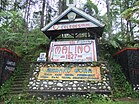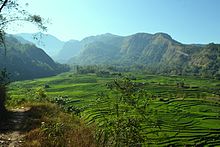Gowa Regency (original) (raw)
Regency in South Sulawesi, Indonesia
| Gowa Regency Kabupaten Gowa ᨅᨘᨈ ᨁᨚᨓ | |
|---|---|
| Regency | |
    Clockwise from top : Lontara' Script in Balla Lompoa, Tamalate Palace, The Twin Bridge and Jeneberang River, Syech Yusuf Great Mosque, Fort Somba Opu, Malino Town City of Flower Clockwise from top : Lontara' Script in Balla Lompoa, Tamalate Palace, The Twin Bridge and Jeneberang River, Syech Yusuf Great Mosque, Fort Somba Opu, Malino Town City of Flower |
|
 Seal Seal |
|
| Motto(s): Rewako GowaSlogan: Gowa Bersejarah Clean, prosperous, neat, safe, and green. | |
 Location within South Sulawesi Location within South Sulawesi |
|
  Gowa RegencyLocation in Sulawesi Gowa RegencyLocation in Sulawesi |
|
| Coordinates: 5°19′3″S 119°44′23″E / 5.31750°S 119.73972°E / -5.31750; 119.73972 | |
| Country |  Indonesia Indonesia |
| Province |  South Sulawesi South Sulawesi |
| Founded | 17 November 1320 |
| Capital | Sungguminasa |
| Government | |
| • Regent | Adnan Purichta Ichsan Yasin Limpo |
| Area | |
| • Total | 1,883.33 km2 (727.16 sq mi) |
| Population (mid 2023 Estimate)[1] | |
| • Total | 799,999 |
| • Density | 420/km2 (1,100/sq mi) |
| Time zone | UTC+8 (WITA) |
| Website | Official Website of the Government of Gowa Regency |
Gowa (Makassar language : ᨁᨚᨓ) is a regency in the province of South Sulawesi, Indonesia. It has an area of 1,883.33 km2 and a population of 652,329 at the 2010 census,[2] increasing to 765,836 at the 2020 census;[3] the official estimate at mid-2023 was 799,999 (comprising 396,130 males and 403,869 females).[1] The majority of the regency (the western eleven districts, with 632,039 inhabitants, or just over 79% of the regency's population in mid 2023) lies within the official metropolitan area of the city of Makassar, including the regency's administrative capital at Sungguminasa. The hill resort of Malino is in the eastern (non-metropolitan) part of the regency.
Gowa is located at 12°38.16'E Longitude of Jakarta and 5°33.6'E longitude of the North Pole. While the location of the region his administration between, 12°33.19 'to 13°15:17'E longitude and 5°5' to 5°34.7'S latitude of Jakarta.
The regency is located in the southern part of South Sulawesi province, and is bordered to the north by the city of Makassar and Maros Regency, to the east by Sinjai Regency, Bulukumba Regency and Bantaeng, to the south by Takalar and Jeneponto Regencies, and to the west by the city of Makassar and Takalar Regency.
The total area is 1,883.33 km2, equal to 3.01% of the area of South Sulawesi province. Gowa regency is divided into eighteen districts, comprising 167 villages and 726 hamlets.
The Bili-Bili Dam, located about 30 km from Makassar, was completed in 1998.[4]
Administrative districts
[edit]
The regency is divided into eighteen districts (kecamatan), with their area, population at the 2010[2] and 2020 census,[3] and the mid-2023 official population estimate tabulated below.[1] The table also includes the locations of the district administrative centres, their post code and the number of administrative villages in each district (totaling 121 rural desa and 46 urban kelurahan).
| Location | Kode Wilayah | Name ofDistrict(kecamatan) | Area in km2 | Pop'ncensus2010 | Pop'ncensus2020 | Pop'nEstimatemid 2023 | Admincentre | No. of villages | Postcode |
|---|---|---|---|---|---|---|---|---|---|
 |
73.06.01 | Bontonompo | 30.39 | 39,295 | 44,998 | 46,409 | Tamallayang | 14 (a) | 92153 |
 |
73.06.16 | Bontonompo Selatan (South Bontonompo) | 29.24 | 28,471 | 32,118 | 32,323 | Pabundukang | 9 (b) | 92154 |
 |
73.06.02 | Bajeng | 60.09 | 62,334 | 72,066 | 75,345 | Kalebajeng | 14 (c) | 92152 |
 |
73.06.18 | Bajeng Barat (West Bajeng) | 19.04 | 22,918 | 26,639 | 28,264 | Borimatangkasa | 7 | 92151 |
 |
73.06.07 | Pallangga | 48.24 | 98,721 | 127,837 | 132,064 | Mangalli | 16 (d) | 92161 |
 |
73.06.12 | Barombong | 20.67 | 34,527 | 45,192 | 46,720 | Kanjilo | 7 (e) | 90225 |
 |
73.06.08 | Somba Opu | 28.09 | 130,287 | 156,108 | 156,098 | Sungguminasa | 14 (f) | 92111-92119 |
 |
73.06.06 | Bontomarannu | 52.63 | 31,250 | 41,016 | 44,605 | Borongloe | 9 (g) | 92171 |
 |
73.06.13 | Pattallassang | 84.96 | 21,881 | 30,254 | 34,568 | Pattallassang | 8 | 92172 |
 |
73.06.05 | Parangloe | 221.26 | 16,564 | 18,628 | 19,577 | Lanna | 7 (h) | 92179 |
 |
73.06.14 | Manuju | 91.90 | 14,093 | 14,591 | 16,066 | Moncongloe | 7 | 92173 |
 |
73.06.04 | Tinggimoncong | 142.87 | 22,138 | 23,331 | 23,667 | Malino | 7 (j) | 92178 |
 |
73.06.10 | Tombolo Pao | 251.82 | 26,876 | 29,779 | 31,096 | Tamaona | 9 (k) | 92170 |
 |
73.06.17 | Parigi | 132.76 | 13,089 | 13,289 | 14,032 | Majannang | 5 | 92174 |
 |
73.06.09 | Bungaya | 175.53 | 15,847 | 16,742 | 18,465 | Sapaya | 7 (l) | 92177 |
 |
73.06.15 | Bontolempangan | 142.46 | 13,332 | 14,781 | 17,042 | Bontoloe | 8 | 92176 |
 |
73.05.03 | Tompobulu | 132.54 | 28,971 | 28,393 | 30,659 | Malakaji | 8 (m) | 92175 |
 |
73.06.11 | Biringbulu | 218.84 | 32,347 | 30,073 | 32,999 | Lauwa | 11 (n) | 90244 |
| Gowa Regency | 1,883.33 | 652,941 | 765,836 | 799,999 | 167 | ||||
| of which the part | within the | metropolitan area | 686.51 | 500,341 | 609,447 | 632,039 | 112 |
Notes: (a) includes the 3 kelurahan of Bontonompo, Kalaserena and Tamallayang. (b) includes one kelurahan of Bontoramba.
(c) includes the 4 kelurahan of Kalebajeng, Limbung, Mata Allo and Tubajeng. (d) includes the 4 kelurahan of Mangalli, Pangkabinanga, Parangbanoa and Tetebatu.
(e) including the 2 kelurahan of Benteng Somba Opu and Lembang Parang.
(f) all 14 are kelurahan - Batangkaluku, Bonto-Bontoa, Bontoramba, Kalegowa, Katangka, Mawang, Paccinongang, Pandang-Pandang, Romangpolong, Samata, Sungguminasa, Tamarunang, Tombolo and Tompobalang.
(g) including the 3 kelurahan of Bontomanai, Borongloe and Romang Lompoa. (h) including the 2 kelurahan of Bontoparang and Lanna.
(j) comprising 6 kelurahan (Bonto Lerung, Bulutana, Gantarang, Garassi, Malino and Pattapang) and one desa.
(k) including one kelurahan of Tamaona. (l) including the 2 kelurahan of Je'nebatu and Sapaya.
(m) including the 2 kelurahan of Cikoro and Malakaji. (n) including the 2 kelurahan of Lauwa and Tonrorita.
The first eleven of the eighteen districts tabulated above lie within the official metropolitan area of the city of Makassar; the remaining seven districts lie outside that area.
Mineral deposits, group C along the Watershed (DAS) Jenebarang, such as sand, stone and gravel hereditary able to provide for the surrounding population. The contribution of this sector in economic activity in 2000 amounting to Rp.105,4 billion, or 9.13 percent, but the contribution of this sector to the regency government's treasury is significant.
In fiscal year 2001, the district government targeted Rp. 2.03 billion of tax excavated material to fill a class C revenue (PAD). Quarrying activities was quite large because in addition to the availability of material from the DAS, there was also mountain stone and clay. The trucks transporting this material moved along protocol roads connecting with Gowa Makassar.
Excavated material is capable of providing for cash receipts for Gowa Regency. Pos dominates income tax up to 65 percent in the 2001 fiscal year revenue in the amount of Rp. 3.11 billion.
Gowa real potential is agriculture. The main job of the regencies in 2000 per capita income of Rp. 2.09 million are farming, with food crops sub-sector as the mainstay. The agricultural sector contributed 45 percent or Rp. 515.2 billion.
Rice Field in Parigi, Gowa Regency, South Sulawesi
Paddy fields were less than 20 percent (3,640 hectares) of the total land area of the regency is able to provide sufficient results. Production of various agricultural crops such as rice and other crops, horticultural crops to be excellent.
Sub-districts in the highlands like Parangloe, Bungaya and especially Tinggimoncong a vegetable producing center. The most widely cultivated vegetables are potatoes, cabbage, mustard, onion and beans. Per year, the harvest of vegetables exceed 5,000 tons. Vegetables of Gowa Makassar city is able to meet the market and its surroundings, even to the island of Borneo and the Maluku through the port of Pare Pare and Port Mamuju.
In addition to farming vegetables that have a short growing season, farmers Gowa also many who farm crops longevity. One of them is the passion fruit plants (Fassifora sp). Visited Makassar less afdol feel if not bring fruit or juice passion fruit syrup hands. If we look at the views of the airport or the port, most of the passengers who will leave Makassar bring this fresh flavorful juice. Plants from the mainland of South America is synonymous with South Sulawesi. Kanreapia Village, District Tinggimoncong is one of passion fruit producing areas in Gowa. Unfortunately, passion fruit sour taste of the fruit is sweet and capable of moving a small food and beverage industry is now beginning farmers less desirable. Planting of passion is not easy, except for the long cropping period and require special care, such as high surface soil, fertilizers and drugs are quite expensive.
Furthermore, the price of passion fruit is also unstable and likely to continue to decline. These vines have one harvests per year (November to January) with a production of about 300,000 fruit per hectare. If the price at the time of harvest, one kilo (approximately 25 pieces) only Rp. 500,- up to Rp. 800,-[_citation needed_] so that farmers only received Rp 6.0 million to Rp 9.6 million per hectare. This situation drives the passion fruit planting area continued to decline. In 1996 there were 1,241 hectares with a production of 21,861 tonnes. Four years later planting area into 854 hectares with a production of 7,189 tons. Many farmers to switch crops from passion fruit to vegetables for more
One of the most important sights is Fortress Samba Opu (Benteng Samba Opu) in the town of Sunggumninasa. A part of the walls including a round tower are just being restored. The strongest wall with a thickness of seven metres was built in the west towards the sea as Sultan Hasanuddin feared an attack from this direction.[5] Weapons, coins, traditional clothing etc. are on display in a museum in the middle of the fortress. Various houses in the traditional styles of eleven different peoples of southern Sulawesi were built in the fortress.
Parangloe Tiered Waterfall
[edit]
Parangloe Tiered Waterfall is located in Parangloe district, 42 kilometers east of Makassar with severely damaged road and then 1.5 kilometers in a half hour walk.[6]
Fortress Samba Opu
Sultan Hasanuddin of Gowa
Mangi Mangi Karaeng Bontonompo, king of Gowa, with the public and some dignitaries during the installation of acting governor of Celebes and dependencies, Mr. Bosselaar, 1937
Western wall of the fortress
Wall being restored
Museum and canon in the fortress of Samba Opu
- ^ a b c Badan Pusat Statistik, Jakarta, 28 February 2024, Kabupaten Gowa Dalam Angka 2024 (Katalog-BPS 1102001.7306)
- ^ a b Biro Pusat Statistik, Jakarta, 2011.
- ^ a b Badan Pusat Statistik, Jakarta, 2021.
- ^ Andi Hajramurni (2010-05-21). "Makassar dam threatened by sediment, experts say". The Jakarta Post. Retrieved 2014-07-25.
- ^ Nurul Noe: Makassar dan sekitarnya, p.28. Jakarta 2014
- ^ "The Tempting Parangloe Waterfall". September 17, 2014.




